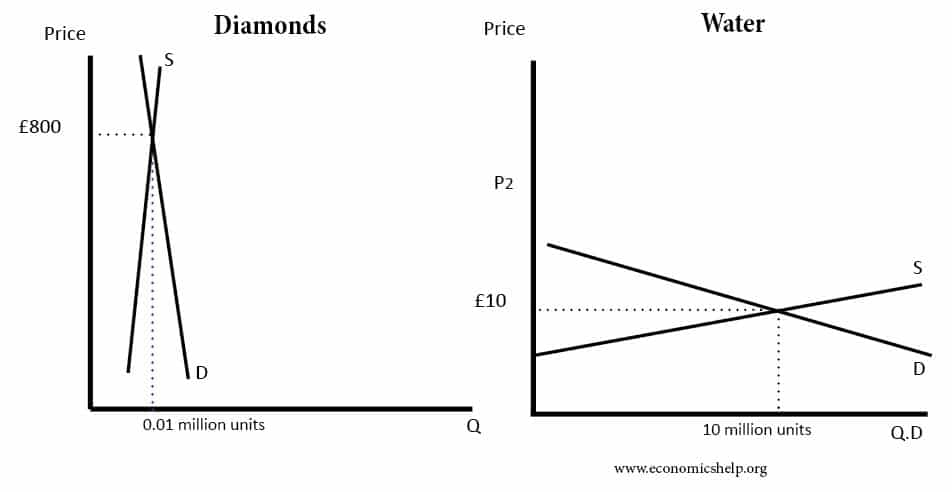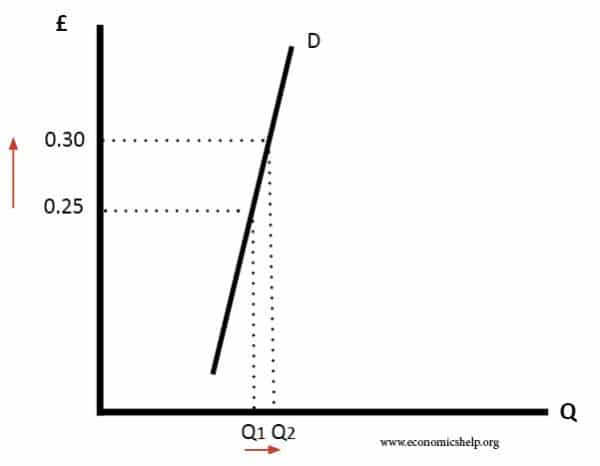Definition
The observation that some goods (e.g. water) which are more essential to human life can be cheaper than non-essential goods (e.g. diamonds)
Explanation
The paradox of value examines why goods that are not essential to life can command a much higher price than goods that are essential to life. For example, a classic example is the price of water and diamonds. Diamonds are mere accoutrements and jewellery, yet they can sell for thousands of pounds. Water, essential for life, can be taken from a tap at a very low cost. Why do we seem to place a greater value on diamonds than water?
Reasons for the paradox of value
Context/ marginal utility. First of all, if you were in a desert, dying of thirst, you might be willing to sell every diamond you have in return for a litre of water. Context is important. We spend more on diamonds only when we have sufficient water.
The marginal utility of water is fairly constant. Each day water gives a certain marginal utility (satisfaction). We need to keep buying and using water every day of our life. However, the marginal utility of diamonds is very different. Before getting married, a diamond ring brings a very high level of marginal utility – so we are willing to pay £1,000. But a week later, the marginal utility of another diamond would be very significantly lower. We don’t need to buy a diamond every week. If we did, it would lose its appeal of being a special one-off.
If you were in a desert and dying of thirst, the marginal utility of a diamond would be practically zero, but the marginal utility of water would be very high. In this situation, the market price of water and diamonds would radically change.
Total expenditure. Related to this concept of marginal utility is how much do you spend on water and diamonds throughout your lifetime? If we take my father, he bought one diamond wedding ring in 1960 for let’s say £800 in 2021 prices. But, every year as a householder he has paid water bills of around £300 a year. Therefore, if he has paid 50 years x £300 for tap water. Total £15,000. The total spending on water is much greater than his lifetime spending on diamonds. Also, he will have spent thousands on drinks that are 95% water, with a touch of alcohol or flavouring. Therefore, although the price of diamonds is higher than water. The total amount spent is very different. We buy diamonds maybe once or twice in a lifetime (apart from the super-rich), but we are buying water virtually every day.
Inelastic supply of diamonds. Thirdly, the price is determined by supply and demand. The supply of water and diamonds is very different. The supply of tap water is very elastic (especially in the UK with a lot of rain). Therefore, even as demand rises, price increases only a little. The supply of diamonds is very limited, therefore, supply is inelastic. It is the rarity of diamonds that is pushing up the prices.
On the left supply is elastic (like water). On the right, supply is inelastic like diamonds.
If there was a big increase in the supply of diamonds, the price would fall. Would we buy more diamonds? Probably not that many more. I imagine the demand for diamonds is very inelastic. Even if the price goes up, we need to buy one wedding ring, if the price goes down, we don’t need to buy several wedding rings.
High price/rarity makes diamonds more attractive. Fourthly, my father could have bought a wedding ring made out of fake diamonds, which look similar but are much cheaper. However, there are some goods where the rarity and high price actually make it more attractive than a cheaper version. If you are buying a wedding ring, it symbolises commitment, good faith, security. You want to get the best possible ring, not the cheapest possible price (even as a Yorkshireman, my Dad would understand that). Therefore, we value a diamond ring, precisely because it is expensive and rare. If you were buying wedding rings every month, it might be different, you would buy the cheaper substitute. But for a once in a lifetime purchase, you could argue a wedding ring is like a Veblen good – the higher price makes it more desirable.
Are diamonds a Veblen good with an upward-sloping demand curve?
Veblen goods contradict the basic law of demand. We demand more as price rises. For a wedding ring, you could argue there is more demand for expensive rings than the cheapest. Hardly anyone takes their fiancé into a jeweller and says ‘give us your cheapest ring!’ – I would but maybe that is why I never got married!
Some people would not buy the most expensive, some with high income may value diamonds more simply because they are expensive.



Thanks so much for this video and explanation. So simple words and easy explanation.
Dear Tejvan Pettinger,
I read your explanation of the Value Paradox with interest. Good text. The texts of other authors are much worse because they have errors. Your text should also be improved. This would require the use of the newly developed Theory of Financial Saturation.